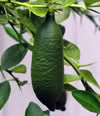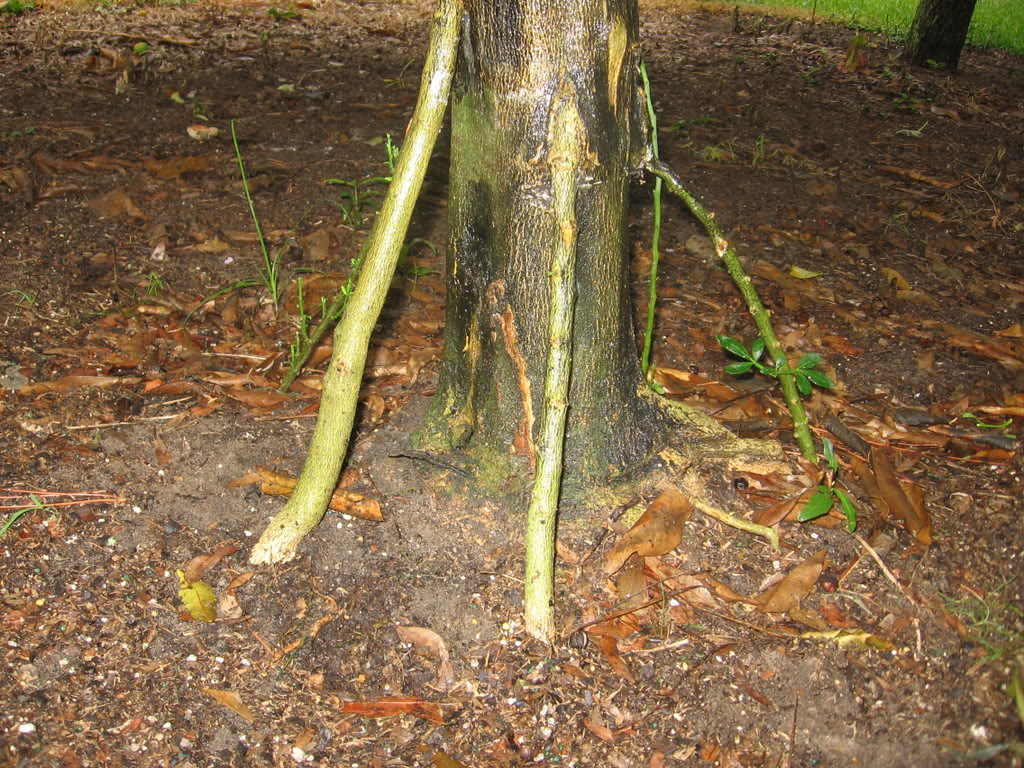 |
Citrus Growers Forum
This is the read-only version of the Citrus Growers Forum.
Breaking news: the Citrus Growers Forum is reborn from its ashes!
Citrus Growers v2.0
|
|
|
|
Multiple rootstocks, anyone?
Goto 1, 2 Next
|
| Author |
Message |
JoeReal
Site Admin


Joined: 16 Nov 2005
Posts: 4726
Location: Davis, California
|
| Posted: Mon 01 Oct, 2007 4:04 pm |
|
Has anyone tried multiple rootstocks on citruses?
Not only can we multigraft several cultivars unto one rootstock, but we can certainly graft one scion cultivar and have it supported by multiple rootstocks. Skeptics call it fancy grafting without added benefits at all, while people doing this with their mango trees in the Philippines have realized benefits in some areas of the country.
Setting aside the costs of doing so, meaning, not really doing economics and commercial applications, just from the point of view of learning something new for citruses, there could be sound ecological theories as to how it could be beneficial. And this is my speculations gathered from an earlier thread that I have posted earlier and you can revisit it here, now that this rootstock forum is a good place to discuss such ideas, useful or otherwise: link
If you don't have time to look through it, this is how my speculation goes:
If you use more than one of the same clonal rootstocks for a single cultivar, that is a wasted effort. But if you use non-sibling rootstock, it would dramatically improve the whole tree's vigor and productivity due to a more aggressive root interactions and hence more efficient nutrient acquisition.
Other advantages that have been mentioned by proponents of multiple rootstocks is that you would have a wider swath of adaptability with two different rootstock types. If one doesn't perform well, the others will simply take over, increasing chances of survival or adaptation. It also minimizes chances of decline from long term graft incompatibility as the others will simply dominate the non-adapted ones.
But it is important to note that in some plants, it has been proven that plants can recognize when they are potted with their siblings or with strangers. | Quote: | | When strangers share a pot, they develop a competitive streak, but siblings are more considerate of each other. "The ability to recognize and favor kin is common in animals, but this is the first time it has been shown in plants," said Susan Dudley of McMaster University in Canada. After plants are potted, roots branch out to suck up water and nutrients. But when several plants of the same species are potted together, things get a little nasty: Each plant flexes its muscles, so to speak, by extending its root growth to try and snatch up valuable resources. Unless, that is, the plants are siblingseach having come from the same mother plantin which case they become very accommodating, allowing each other ample root space. Because the interactions between related and unrelated plants only happened when plants were in the same pot, where root space is limited, root interactions are likely what gives plants the cue that their neighbor is related. The findings, detailed in the June 12 issue of Biology Letters, may not come as a surprise to seasoned gardeners. |
When two non-sibling plants are planted together in one hole so that their roots come in contact, they would try to flex their resources to reach out the prime space within the same soil, so that whoever will dominate first, will be assured of long term success in the same piece of soil. Then this is reflected back into their above ground growth. Whoever has more established roots occupying the prime spot will be able to invest more in reaching out for the sun dominating the space. So the other one will be out-competed with another.
Now what happens if those two non-sibling plants are grafted unto one scionwood. Of course, they would still flex to out-compete each other in terms of soil space acquisition, but something here is different in that now they support only one plant which in turn support them. What happens here is that we have much more vigorous root system when two non-sibling rootstocks are used, and thus are more likely to have better supply of nutrients to the same scionwood. This is in addition to the perceived advantages of having wider adaptability and hence reliability if rootstocks of different parents are used. Thus it wouldn't make sense to do multiple rootstocks if the rootstocks are either clonal or siblings (coming from the same parents). So if ever multiple rootstocks are used, it would be preferable that the rootstocks be not of the same parents and obviously, different cultivar rootstocks are by default, not from the same parents.
This very same observation can be taken advantage of in another way, and would lend support to the practice of planting multiple trees in one hole if they have clonal or sibling rootstocks. Thus with clonal rootstocks application you can achieve high density plantings even in one hole, or closer together. For those using clonal rootstocks with different cultivars grafted over them, it is recommended practice for home gardeners to plant them together into one hole if you don't know how to graft. The Clonal rootstocks won't compete with each other even if they have different cultivars grafted over them. I have done multiple cultivar planting into one hole and have proven that it works and the trees are now big in my yard. The reason why it worked is because the rootstocks are either siblings or clonal and were fully cooperating with each other, and the one hole with several trees behaved exactly like the size of one regular tree. Of course you would have to know the stature of the cultivar when grafted unto particular rootstock. You would then position the more vigorous grafts towards the north, the less vigorous towards the south, and those of medium and equal vigor to the east and west.
But if the rootstocks are non clonal nor are siblings from the same mother, when you plant them into one hole, then it would be the survival of the most competitive in that one hole.
There is also a chance with specific combo that it will not necessarily work, as there is that scionwood interaction where perhaps the same plant signals, ie, hormones, are passed to the roots so that the different rootstocks in turn would be cooperative rather than competitive. But it is nonetheless exciting to find out.
I will try multiple rootstocks once I get my other rootstocks going. I plan to experiment with Volkameriana and Pummelo or other combos like Yuzu, Sudachi and Trifoliate. But of course never Volk with Flying Dragon together. |
|
| Back to top |
|
 |
JoeReal
Site Admin


Joined: 16 Nov 2005
Posts: 4726
Location: Davis, California
|
|
| Back to top |
|
 |
Laaz
Site Owner


Joined: 12 Nov 2005
Posts: 5657
Location: Dorchester County, South Carolina
|
| Posted: Thu 25 Oct, 2007 7:10 pm |
|
Ned posted a photo of his inarching somewhere on the forum.

_________________
Wal-Mart a great place to buy cheap plastic crap ! http://walmartwatch.com/ ...
 |
|
| Back to top |
|
 |
JoeReal
Site Admin


Joined: 16 Nov 2005
Posts: 4726
Location: Davis, California
|
| Posted: Thu 25 Oct, 2007 7:47 pm |
|
Are those rootstocks of the same kind? If they are, it is not the same as using different kinds of rootstocks. It will surely be helpful to repair root damages regardless. Use of different kinds of rootstocks as discussed in my earlier post has some advantages that I'd like to exploit, so my trees will later have more types of rootstocks. |
|
| Back to top |
|
 |
dauben
Citruholic


Joined: 25 Nov 2006
Posts: 963
Location: Ramona, CA, Zone 9A
|
| Posted: Sun 02 Mar, 2008 2:24 pm |
|
This is an interesting topic. Since I'm relatively new to citrus and just started growing my own rootstock, I decided to grow Sour Orange. My only concern is with the tristeza virus which may or may not become an issue in the future in my area. I wonder if I used another rootstock that is more resistent if it would be like an added insurance policy. I don't know a lot about tristeza, but I imagine that I would need the scion/buds to be grafted onto the other rootstock. Since the only other rootstock I'm growing is Flying Dragon, I wonder what the tree size I would end up with. I suppose I could use an interstock with both rootstocks grafted onto it, but that sounds like it's becoming a pretty complicated tree. . .
Phillip |
|
| Back to top |
|
 |
JoeReal
Site Admin


Joined: 16 Nov 2005
Posts: 4726
Location: Davis, California
|
| Posted: Sun 02 Mar, 2008 4:04 pm |
|
Not by much you can do about tristeza once it gets in. But for sure, the multiple rootstock is a good insurance against root type diseases. |
|
| Back to top |
|
 |
Ned
Citrus Guru

Joined: 14 Nov 2005
Posts: 999
Location: Port Royal, SC (Zone 8b)
|
| Posted: Mon 03 Mar, 2008 1:00 am |
|
I think I have Swingle, Trifoliate and X638 on the tree pictured, which is an Ambersweet orange. The original objective was to save the tree from a case of foot rot. That has worked, with what seems to be an overall improvement in the health of the tree, something I have noted on this forum before. Because of this experience I also concluded that there might be some nutritional advantage for the tree to having multiple rootstocks.
Ned |
|
| Back to top |
|
 |
Helix
Citruholic

Joined: 04 Jan 2008
Posts: 37
Location: Atwater CA
|
| Posted: Mon 03 Mar, 2008 5:13 pm |
|
Joe you always have interesting ideas and have tried a lot of things. Last year Costco put their remaining fruit trees on sale for 6.50. I bought 4 different peach trees and put two into each hole as close as I could. about 1 inch apart. I didn't know how to graft and thought it would be a cheap way to make a cocktail tree. I don't know what the rootstocks are. So far it is working out OK. New growth is coming out now. I also have a couple of young citrus that died in the freeze but the rootstock is sending up many new branches that I plan to graft on to this year.
Helix |
|
| Back to top |
|
 |
JoeReal
Site Admin


Joined: 16 Nov 2005
Posts: 4726
Location: Davis, California
|
| Posted: Mon 03 Mar, 2008 5:34 pm |
|
Helix, those are standard rootstocks. They grow vigorously and if left unpruned, they could be enormous size. I bought a few from Costco, and they're a pain in my yard to keep to size that I want (12 ft). If I had a bigger yard, they should be no problem.
Anyway, by planting them close together, the total size would be equivalent to one standard tree. So each one should be 1/4 the size of a regular tree if there are 4 in a hole. The rootstocks are of the same type or are siblings, so there should be no severe competition between them. That works well even with Costco trees.
About those citrus rootstock sprouts, T-budding works very well with them. |
|
| Back to top |
|
 |
dauben
Citruholic


Joined: 25 Nov 2006
Posts: 963
Location: Ramona, CA, Zone 9A
|
| Posted: Mon 03 Mar, 2008 6:35 pm |
|
| JoeReal wrote: | | Not by much you can do about tristeza once it gets in. But for sure, the multiple rootstock is a good insurance against root type diseases. |
I was afraid of that. It sounds like maybe the sour orange might be an Achilles heel for the rest of the tree instead of the rest of the tree being a backup for the sour orange if it was to become infected.
Phillip |
|
| Back to top |
|
 |
David.
Citruholic

Joined: 09 Nov 2009
Posts: 400
Location: San Benito , Texas
|
| Posted: Sun 27 Jun, 2010 12:01 am |
|
I know this post is very old but I saw Joe post on the forum recently. Any updates Joe??
Or anyone else tried this to see a flavor difference or vigor??
_________________
South Texas gardener |
|
| Back to top |
|
 |
Millet
Citruholic


Joined: 13 Nov 2005
Posts: 6657
Location: Colorado
|
| Posted: Mon 28 Jun, 2010 1:12 am |
|
Without a doubt, the most famous multiple "rootstocks" ever used in the entire history of the Citrus industry, was the root stocks used in the inarching of the original Parent Washington Navel orange tree, growing on the corners of Magnolia & Arlington avenues in Riverside California. In 1918 it was determined that the Parent Washington Navel was infected with Phytophthora, and was rapidly declining. The tree was inarched with seedlings of Sour Orange, Rough Lemon and Sweet Orange. This inarching quickly restored the health of the tree. Then again in 1951 it was noted that the original inarches again showed lesions of Phytophthora. Therefore a second inarchig was done using 3 seedlings of Troyer citrange and 1 seedling of Trifoliate orange. Once again the second inarching quickly restored the health of the tree. At this writing the Parent Washington Navel Orange, presently at the age of 136 years and 6 months, remains a healthy tree. - Millet (932-) |
|
| Back to top |
|
 |
JoeReal
Site Admin


Joined: 16 Nov 2005
Posts: 4726
Location: Davis, California
|
| Posted: Thu 01 Jul, 2010 3:48 pm |
|
| dauben wrote: | | JoeReal wrote: | | Not by much you can do about tristeza once it gets in. But for sure, the multiple rootstock is a good insurance against root type diseases. |
I was afraid of that. It sounds like maybe the sour orange might be an Achilles heel for the rest of the tree instead of the rest of the tree being a backup for the sour orange if it was to become infected.
Phillip |
It depends. For sure, the mother of all Navels was saved using multiple rootstocks, and in this case, the "Achilles heel" really didn't matter. The proof is that the more than a century old tree is still alive and productive to this very day. |
|
| Back to top |
|
 |
Mark_T
Citruholic


Joined: 30 Jun 2009
Posts: 757
Location: Gilbert,AZ
|
| Posted: Mon 26 Jul, 2010 9:53 pm |
|
So for a dummy like me, this process is basically using different rootstocks, like the case of the "Parent Washington" and grafting them to the original rootstock? So the new rootstocks are able to feed and support the old rootstock despite the disease? Do I have that right?
Citrus never ceases to amaze me. |
|
| Back to top |
|
 |
Mark_T
Citruholic


Joined: 30 Jun 2009
Posts: 757
Location: Gilbert,AZ
|
| Posted: Mon 26 Jul, 2010 9:56 pm |
|
By the way, I must give sweeping praise to Citrange for his citrus website. He really does an amazing job. Thank you Citrange! |
|
| Back to top |
|
 |
| Informations |
 |
Our users have posted a total of 66068 messages
We have 3235 registered members on this websites
|
| Most users ever online was 70 on Tue 30 Oct, 2012 10:12 am |
Powered by phpBB © 2001, 2005 phpBB Group
|
|






























